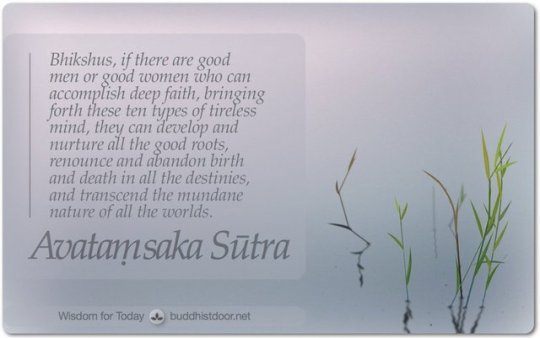#Avataṃsaka Sūtra
Text
From “The Flower Bank World” in the Avatamsaka Sutra

The Buddhist Painting of Songgwansa Temple, Suncheon, South Korea (Illustration of Avatamsaka Sutra)
“Then Universally Good also said to the assembly, ‘In the land masses of this ocean of worlds are seas of fragrant waters, as numerous as atoms in unspeakably many buddha-fields. All beautiful jewels adorn the floors of those seas; gems of exquisite fragrances adorn their shores. They are meshed with luminous diamonds. Their fragrant waters shine with the colors of all jewels. Flowers of all kinds of gems swirl on their surfaces. Sandalwood powder settles on the bottom of the seas. They emanate the sounds of Buddhas’ speech. They radiate jewellike light. Boundless enlightening beings, holding various canopies, manifest mystic powers causing the adornments of all worlds to appear therein. Stairways of ten kinds of precious substances are set out in rows, with balustrades of ten kinds of jewels surrounding them. White lotuses ornamented with jewels, as many as atoms in four continents, are spread over the waters, in full bloom. There are unspeakable hundreds of thousands of billions of trillions of banners of ten precious elements, banners of belled gauze of raiments of all jewels, as many as sand grains in the Ganges river, jewel flower palaces of boundless forms, as many as sand grains in the Ganges river, a hundred thousand billion trillion lotus castles of ten precious substances, forests of jewel trees as many as atoms in four continents, networks of flaming jewels, as many sandalwood perfumes as grains of sand in the Ganges, and jewels of blazing radiance emitting the sounds of Buddhas’ speech…”
--From book five “The Flower Bank World” in the The Flower Ornament Scripture (Buddhāvataṃsaka Sūtra), translated from Chinese by Thomas Cleary. The various sutras were originally composed in Sanskrit and compiled and translated into Chinese in the 5th century CE. Thomas Cleary’s English translation is based on the Chinese translation done by the Khotanese monk Shikshananda (652-710 CE), who translated it at the request of the Tang Empress.
I stumbled upon this sutra in the back of a book that included a ‘glossary of buddhist terms’ while at a Zen meditation retreat. Flower cosmology? That sounds like my shit. Since I didn’t have my phone I wrote the name down on a piece of paper and slipped it into my backpack. It really is as incredible as I imagined it to be.
“Alan Fox has described the sutra's worldview as ‘fractal’, ‘holographic’, and ‘psychedelic’”—yes.
“In the Huayan school, the teaching of interpenetration is depicted through various metaphors, such as Indra's net, a teaching which may have been influenced by the Gandhavyuha chapter's climax scene in Vairocana's Tower. Indra's net is an infinite cosmic net that contains a multifaceted jewel at each vertex, with each jewel being reflected in all of the other jewels, ad infinitum. Thus, each jewel contains the entire net of jewels reflected within.”
#Avataṃsaka Sūtra#Avatamsaka Sutra#flower garland sutra#Hwaeom#Kegon#Huayan Buddhism#Huayan#chan buddhism#Xianshou#water#buddhism#religion#mysticism#Thomas Cleary#literature#philosophy#metaphysics of flowers#The Flower Ornament Scripture#Buddhāvataṃsaka Sūtra#Buddhāvataṃsaka-nāma-mahāvaipulya-sūtra#Sanskrit
66 notes
·
View notes
Note
So, what IS the Samadhi Fire/True Fire of Samadhi? It can't be an average flame if it can take out Sun Wukong himself in JttW and the name sounds like it means something, but I can't find any context when I look it up.
Journey to the West states that Samādhi fire is not like earthly or heavenly flame. It is something more. Part of a poem in chapter 41 reads:
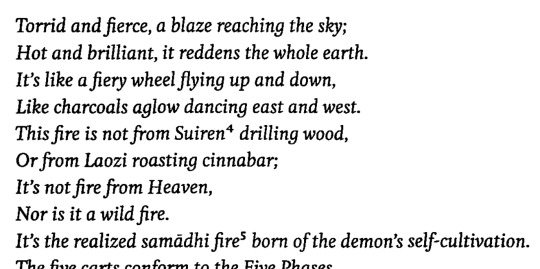
(Wu & Yu, 2012, vol. 2, p. 225)
The general concept of Samādhi (Sk: "concentration"; Ch: sanmei, 三昧) refers to an advanced level of meditation where one can "establish and maintain one-pointedness of mind on a specific object of concentration" (Buswell & Lopez, 2014, p. 743). Some Hindu and Buddhist sources associate it with a spiritually cleansing flame. One example comes from the Gaṇḍavyūha section of the Avataṃsaka Sūtra (Ch: Dafang guangfo huayan jing, 大方廣佛華嚴經; compiled by the 3rd or 4th-century CE).
Sudhana (Ch: Shancai tongzi, 善財童子; i.e. Red Boy), the holy work's protagonist, seeks out 53 teachers in the course of his spiritual cultivation. His ninth instructor, a learned Brahmin named Jayoṣmāyatana (Ch: Shengre poluomen, 勝熱婆羅門; lit: "Victorious Heat Brahmin") is said to have achieved "the light of the concentration [i.e. Samādhi] of adamantine flame" (jingang yan sanmei guangming, 金剛焰三昧光明) (Clearly, 1993, p. 1218). The fire that he produces is so powerful that it scares even the gods and demons. Though, the point of the flames appears to be incineration of the ego and desires and illumination of the mind. Sudhana follows his instructions by throwing himself into the fire, thus gaining a higher level of spiritual knowledge.
Here is a translation of that section of the sutra (warning: it is wordy):
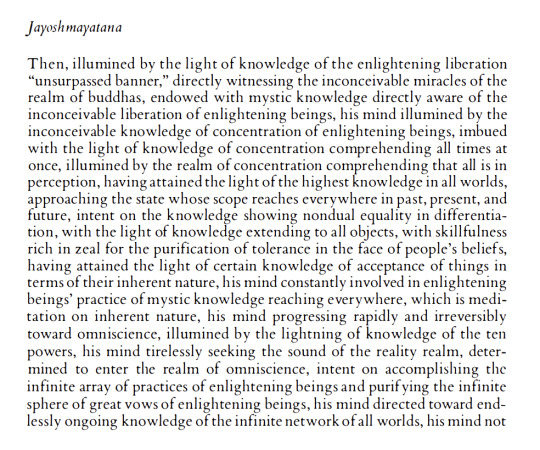

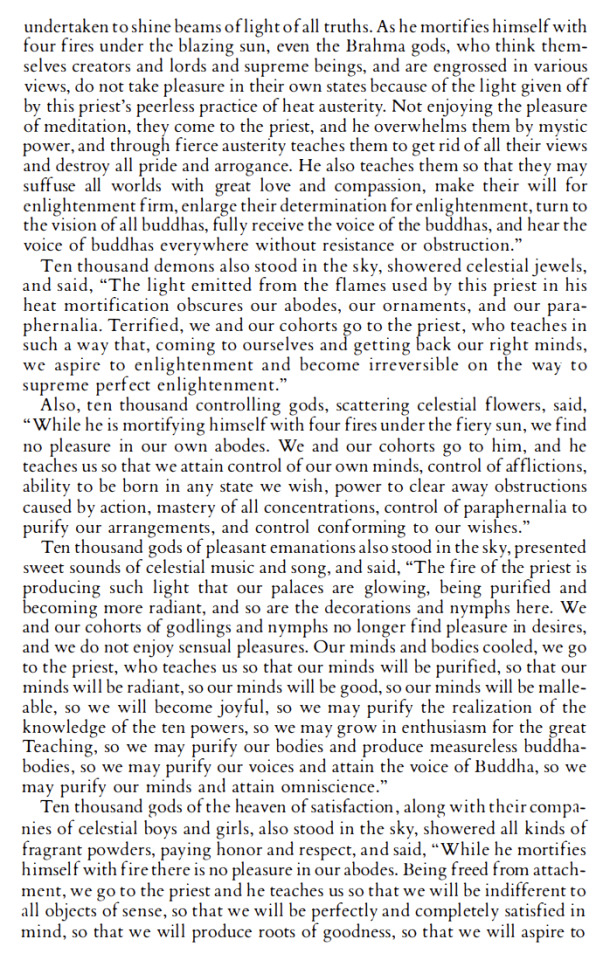
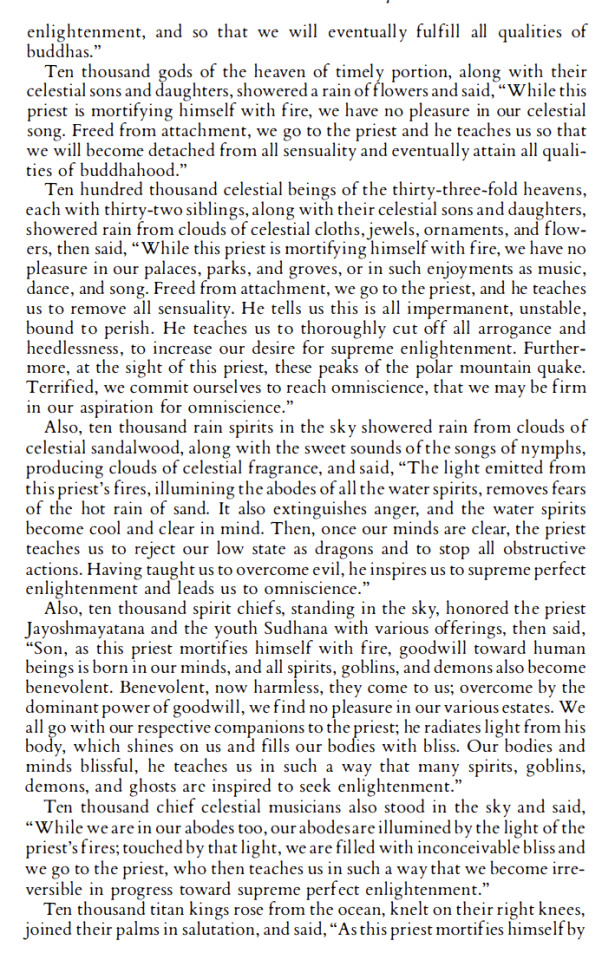
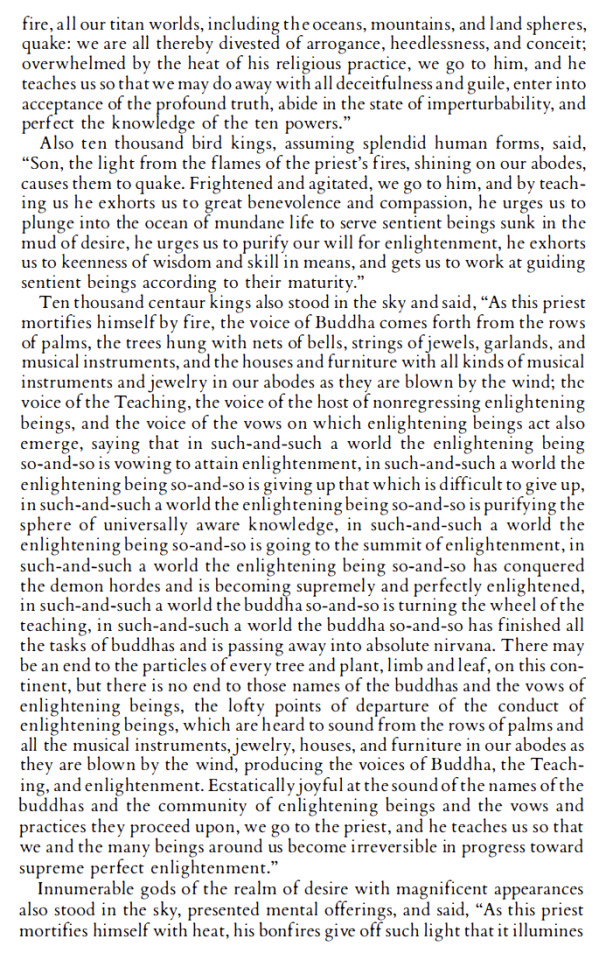
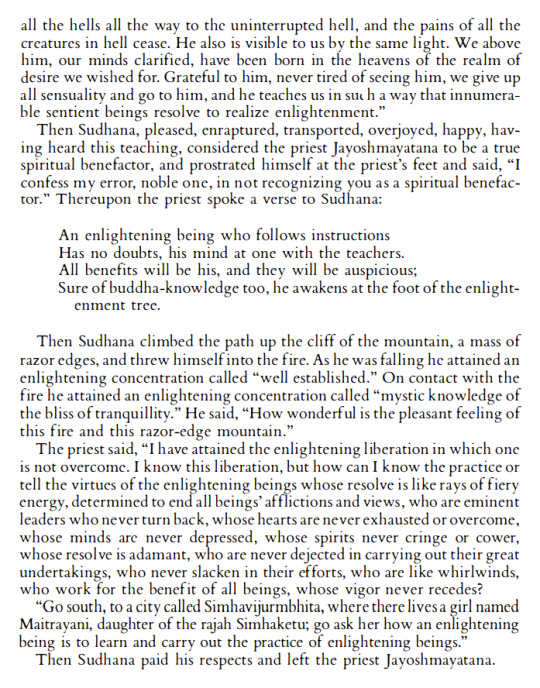
(Clearly, 1993, pp. 1217-1222)
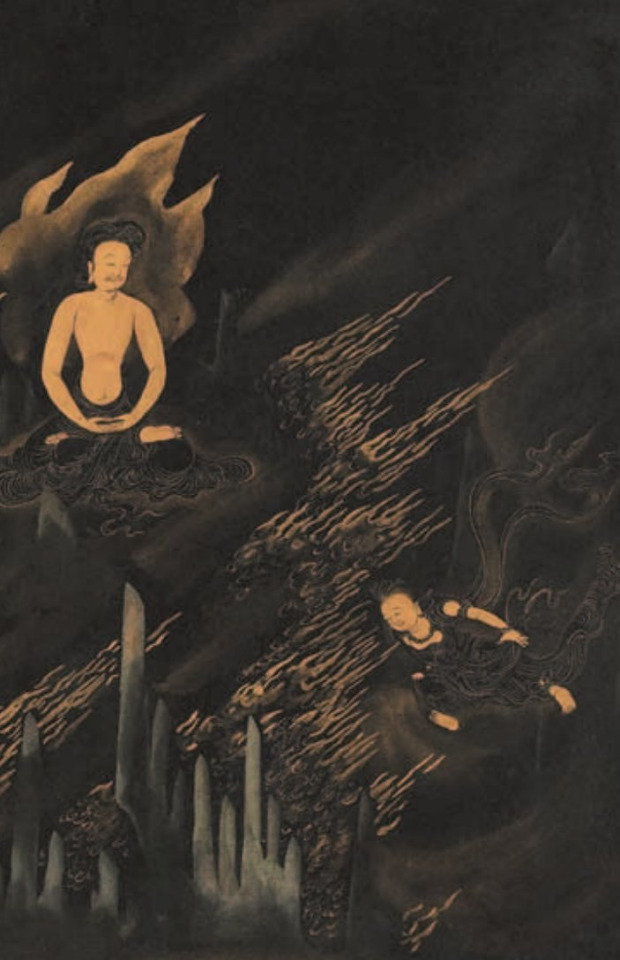
A Song or Ming-era Japanese painting of the fire brahmin and Sudhana.
Sources:
Buswell, R. E. , & Lopez, D. S. (2014). The Princeton Dictionary of Buddhism. Princeton University Press.
Cleary, T. (1993). The Flower Ornament Scripture: A Translation of the Avatamsaka Sutra. Boston: Shambhala.
Wu, C., & Yu, A. C. (2012). The Journey to the West (Vols. 1-4) (Rev. ed.). Chicago, Illinois: University of Chicago Press.
#Samadhi fire#Samadhi flame#Red Boy#Red Son#Journey to the West#JTTW#Buddhism#Hinduism#Samadhi#Lego Monkie Kid#Sudhana#Shancai tongzi#Chinese religion#Indian religion#meditation
98 notes
·
View notes
Text
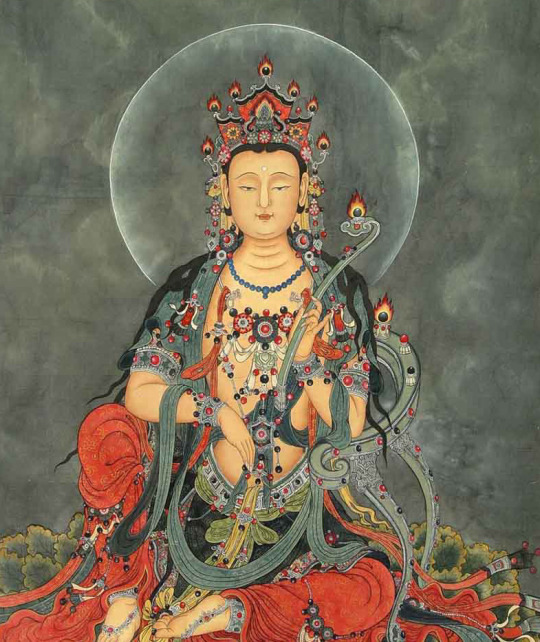

The King of Aspiration Prayers: Samantabhadra’s “Aspiration to Good Actions” (Zangchö Mönlam)
from the Gaṇḍavyūha chapter of the Avataṃsaka sūtra
The Translators’ Homage
Homage to Mañjuśrī, the youthful!
The Seven Preliminaries for Purifying the Mind
1. Prostration
To all the buddhas, the lions of the human race,
In all directions of the universe, through past and present and future:
To every single one of you, I bow in homage;
Devotion fills my body, speech and mind.
Through the power of this prayer, aspiring to Good Action,
All the victorious ones appear, vivid here before my mind
And I multiply my body as many times as atoms in the universe,
Each one bowing in prostration to all the buddhas.
2. Offering
In every atom preside as many buddhas as there are atoms,
And around them, all their bodhisattva heirs:
And so I imagine them filling
Completely the entire space of reality.
Saluting them with an endless ocean of praise,
With the sounds of an ocean of different melodies
I sing of the buddhas’ noble qualities,
And praise all those who have gone to perfect bliss.
To every buddha, I make offerings:
Of the loveliest flowers, of beautiful garlands,
Of music and perfumed ointments, the best of parasols,
The brightest lamps and finest incense.
To every buddha, I make offerings:
Exquisite garments and the most fragrant scents,
Powdered incense, heaped as high as Mount Meru,
Arranged in perfect symmetry.
Then the vast and unsurpassable offerings—
Inspired by my devotion to all the buddhas, and
Moved by the power of my faith in Good Actions—
I prostrate and offer to all you victorious ones.
3. Confession
Whatever negative acts I have committed,
While driven by desire, hatred and ignorance,
With my body, my speech and also with my mind,
Before you, I confess and purify each and every one.
4. Rejoicing
With a heart full of delight, I rejoice at all the merits
Of buddhas and bodhisattvas,
Pratyekabuddhas, those in training and the arhats beyond training,
And every living being, throughout the entire universe.
5. Imploring the Buddhas to Turn the Wheel of Dharma
You who are like beacons of light shining through the worlds,
Who passed through the stages of enlightenment, to attain buddhahood, freedom from all attachment,
I exhort you: all of you protectors,
Turn the unsurpassable wheel of Dharma.
6. Requesting the Buddhas not to Enter Nirvāṇa
Joining my palms together, I pray
To you who intend to pass into nirvāṇa,
Remain, for aeons as many as the atoms in this world,
And bring well-being and happiness to all living beings.
7. Dedication
What little virtue I have gathered through my homage,
Through offering, confession, and rejoicing,
Through exhortation and prayer—all of it
I dedicate to the enlightenment of all beings!
The Actual Aspiration
1. Aspiration for Purity of Attitude
Let offerings be made to buddhas of the past,
And all who now dwell throughout the ten directions of this universe!
Let all who are yet to come swiftly fulfil their wishes
And attain the stages of enlightenment and buddhahood!
Let as many worlds as there are in all the ten directions
Transform into realms that are vast and utterly pure,
Filled with buddhas who have sat before the mighty bodhi tree,
Around them all their bodhisattva sons and daughters!
Let as many sentient beings as there are in all the ten directions
Live always and forever in happiness and health!
Let all beings meet the Dharma
That befits them best! And so may all they hope for be fulfilled!
2. Aspiration Never to Forget the Bodhicitta
As I practise the training for enlightenment,
May I recall all my previous births,
And in my successive lives, through death and through rebirth,
May I always renounce the worldly life!
Training in the footsteps of all the victorious buddhas,
May I bring Good Actions to perfection,
And my moral conduct be taintless and pure,
Never lapsing, and always free from fault!
In the language of the gods, nāgas, and yakṣas,
In the language of demons and of humans too,
In however many kinds of speech there may be—
I shall proclaim the Dharma in the language of all!
Taming my mind, and striving in the pāramitās,
I will never forget the bodhicitta;
May all my harmful actions and the obscurations they cause
Be completely purified, every single one!
3. Aspiration to be Free from Defilements
May I be freed from karma, harmful emotions, and the work of negativity,
And act for all beings in the world,
Just like the lotus flower to which mud and water cannot cling,
Or sun and moon that course unhindered through the sky.
4. Aspiration to Lead Beings to Happiness
Throughout the reach and range of the entire universe
I shall pacify completely the suffering of all the lower realms,
I shall lead all beings to happiness,
And work for the ultimate benefit of each and every one!
5. Aspiration to Wear the Armour of Dedication
I shall bring enlightened action to perfection,
Serve beings so as to suit their needs,
Teach them to accomplish Good Actions,
And continue this, throughout all the aeons to come!
6. Aspiration to Accompany other Bodhisattvas
May I always meet and be accompanied by
Those whose actions accord with mine;
And in body, speech and mind as well,
May our actions and aspirations always be one!
7. Aspiration to Have Virtuous Teachers and to Please Them
May I always meet spiritual friends
Who long to be of true help to me,
And who teach me the Good Actions;
Never will I disappoint them!
8. Aspiration to See the Buddhas and Serve them in Person
May I always behold the buddhas, here before my eyes,
And around them all their bodhisattva sons and daughters.
Without ever tiring, throughout all the aeons to come,
May the offerings I make them be endless and vast!
9. Aspiration to Keep the Dharma Thriving
May I maintain the sacred teachings of the buddhas,
And cause enlightened action to appear;
May I train to perfection in Good Actions,
And practise these in every age to come!
10. Aspiration to Acquire Inexhaustible Treasure
As I wander through all states of samsaric existence,
May I gather inexhaustible merit and wisdom,
And so become an inexhaustible treasury of noble qualities—
Of skill and discernment, samādhi and liberation!
11. Aspiration to the Different Methods for Entering into the “Good Actions”
a) Seeing the Buddhas and their Pure Realms
In a single atom may I see as many pure realms as atoms in the universe:
And in each realm, buddhas beyond all imagining,
Encircled by all their bodhisattva heirs.
Along with them, may I perform the actions of enlightenment!
And so, in each direction, everywhere,
Even on the tip of a hair, may I see an ocean of buddhas—
All to come in past, present and future—in an ocean of pure realms,
And throughout an ocean of aeons, may I enter into enlightened action in each and every one!
b) Listening to the Speech of the Buddhas
Each single word of a buddha’s speech, that voice with its ocean of qualities,
Bears all the purity of the speech of all the buddhas,
Sounds that harmonize with the minds of all living beings:
May I always be engaged with the speech of the buddhas!
c) Hearing the Turning of the Wheels of Dharma
With all the power of my mind, may I hear and realize
The inexhaustible melody of the teachings spoken by
All the buddhas of past, present and future,
As they turn the wheels of Dharma!
d) Entering into All the Aeons
Just as the wisdom of the buddhas penetrates all future aeons,
So may I too know them, instantly,
And in each fraction of an instant may I know
All that will ever be, in past, present and future!
e) Seeing all the Buddhas in One Instant
In an instant, may I behold all those who are the lions of the human race—
The buddhas of past, present and future!
f) Entering the Sphere of Activity of the Buddhas
May I always be engaged in the buddhas’ way of life and action,
Through the power of liberation, where all is realized as like an illusion!
g). Accomplishing and Entering the Pure Lands
On a single atom, may I actually bring about
The entire array of pure realms of past, of present and future;
And then enter into those pure buddha realms
In each atom, and in each and every direction.
h) Entering into the Presence of the Buddhas
When those who illuminate the world, still to come,
Gradually attain buddhahood, turn the Wheel of Dharma,
And demonstrate the final, profound peace of nirvāṇa:
May I be always in their presence!
12. Aspiration to the Power of Enlightenment through Nine Powers
Through the power of swift miracles,
The power of the vehicle, like a doorway,
The power of conduct that possesses all virtuous qualities,
The power of loving kindness, all-pervasive,
The power of merit that is totally virtuous,
The power of wisdom free from attachment, and
The powers of knowledge, skilful means and samādhi,
May I perfectly accomplish the power of enlightenment!
13. Aspiration to the Antidotes that Pacify the Obscurations
May I purify the power of karma;
Destroy the power of harmful emotions;
Render negativity utterly powerless;
And perfect the power of Good Actions!
14. Aspiration to Enlightened Activities
I shall purify oceans of realms;
Liberate oceans of sentient beings;
Understand oceans of Dharma;
Realize oceans of wisdom;
Perfect oceans of actions;
Fulfil oceans of aspirations;
Serve oceans of buddhas!
And perform these, without ever growing weary, through oceans of aeons!
15. Aspiration for Training
a) To Emulate the buddhas
All the buddhas throughout the whole of time,
Attained enlightenment through Good Actions, and
Their prayers and aspirations for enlightened action:
May I fulfil them all completely!
b) To emulate the bodhisattvas: Samantabhadra
The eldest of the sons of all the buddhas
Is called Samantabhadra: ‘All-good’—
So that I may act with a skill like his,
I dedicate fully all these merits!
To purify my body, my speech and my mind as well,
To purify my actions, and all realms,
May I be the equal of Samantabhadra
In his skill in good dedication!
c) Mañjuśrī
In order to perform the full virtue of Good Actions,
I shall act according to Mañjuśrī's prayers of aspiration,
And without ever growing weary, in all the aeons to come,
I shall perfectly fulfil every one of his aims!
16. Concluding Aspiration
Let my bodhisattva acts be beyond measure!
Let my enlightened qualities be measureless too!
Keeping to this immeasurable activity,
May I accomplish all the miraculous powers of enlightenment!
Extent of the Aspiration
Sentient beings are as limitless
As the boundless expanse of space;
So shall my prayers of aspiration for them
Be as limitless as their karma and harmful emotions!
The Benefits of Making Aspirations
1. The Benefits of Making Aspirations in General
Whoever hears this king of dedication prayers,
And yearns for supreme enlightenment,
Who even once arouses faith,
Will gain true merit greater still
Than by offering the victorious buddhas
Infinite pure realms in every directions, all ornamented with jewels,
Or offering them all the highest joys of gods and humans
For as many aeons as there are atoms in those realms.
2. The Thirteen Benefits in Detail
Whoever truly makes this Aspiration to Good Actions,
Will never again be born in lower realms;
They will be free from harmful companions, and
Soon behold the Buddha of Boundless Light.
They will acquire all kind of benefits, and live in happiness;
Even in this present life all will go well,
And before long,
They will become just like Samantabhadra.
All negative acts—even the five of immediate retribution—
Whatever they have committed in the grip of ignorance,
Will soon be completely purified,
If they recite this Aspiration to Good Actions.
They will possess perfect wisdom, beauty, and excellent signs,
Be born in a good family, and with a radiant appearance.
Demons and heretics will never harm them,
And all three worlds will honour them with offerings.
They will quickly go beneath the bodhi-tree,
And there, they will sit, to benefit all sentient beings, then
Awaken into enlightenment, turn the wheel of Dharma,
And tame Māra with all his hordes.
3. The Benefits in Brief
The full result of keeping, teaching, or reading
This Prayer of Aspiration to Good Actions
Is known to the buddhas alone:
Have no doubt: supreme enlightenment will be yours!
Dedication of the Merits of this Meritorious Aspiration
1. Dedication that Follows the Bodhisattvas
Just as the bodhisattva Mañjuśrī attained omniscience,
And Samantabhadra too
All these merits now I dedicate
To train and follow in their footsteps.
2. Dedication that Follows the Buddhas
As all the victorious buddhas of past, present and future
Praise dedication as supreme,
So now I dedicate all these roots of virtue
For all beings to perfect Good Actions.
3. Dedication towards Actualizing the Result
When it is time for me to die,
Let all that obscures me fade away, so
I look on Amitābha, there in person,
And go at once to his pure land of Sukhāvatī.
In that pure land, may I actualize every single one
Of all these aspirations!
May I fulfill them, each and every one,
And bring help to beings for as long as the universe remains!
4. Dedication towards Receiving a Prophecy from the Buddhas
Born there in a beautiful lotus flower,
In that excellent and joyous buddha realm,
May the Buddha Amitābha himself
Grant me the prophecy foretelling my enlightenment!
5. Dedication towards Serving Others
Having received the prophecy there,
With my billions of emanations,
Sent out through the power of my mind,
May I bring enormous benefit to sentient beings, in all the ten directions!
Conclusion
Through whatever small virtues I have gained
By reciting this “Aspiration to Good Actions”,
May the virtuous wishes of all beings’ prayers and aspirations
All be instantly accomplished!
Through the true and boundless merit
Attained by dedicating this “Aspiration to Good Actions”,
May all those now drowning in the ocean of suffering,
Reach the supreme realm of Amitābha!
May this King of Aspirations bring about
The supreme aim and benefit of all infinite sentient beings;
May they perfect what is described in this holy prayer, uttered by Samantabhadra!
May the lower realms be entirely emptied!
This completes the King of Aspiration Prayers, Samantabhadra’s “Aspiration to Good Actions.”
Words of Truth to Accomplish Aspirations
By the blessings of the buddhas who have attained the three kāyas,
And the unchanging truth of reality
As well as the unwavering aspirations of the Saṅgha,
May all the aspirations and dedication prayers be fulfilled!
The dhāraṇī for the accomplishment of all aspirations
tadyathā pañcendriyāvabodhanīye svāhā
#buddha#buddhism#buddhist#dharma#sangha#mahayana#zen#milarepa#tibetan buddhism#thich nhat hanh#buddha samantabhadra#Dilgo Khyentse Rinpoche#Padmasambhava#Guru Rinpoche#Longchenpa#Avalokiteshvara#Dzogchen
3 notes
·
View notes
Text
“To talk of the size of a thought is odd, perhaps, but to say that someone is thinking big thoughts is not without meaning. "I want you all to come to my birthday party" is a bigger thought than "I want only some of you to come." Bodhicitta is theoretically the biggest thought anyone can think because of the number of beings involved, what it wants them to have, and the length of time it must last before its motivating power dies out. Since the duration of a thought is a variable of the aim, in the sense that the actions motivated by a thought cease when the aim is attained, one can conceive of thoughts that last longer and longer. Bodhicitta necessarily lasts until the last living being reaches the state free of suffering, because it is only then that the aim is finally achieved. This explains the prayer of Samantabhadra at the end of the Gandavyūha section of the Avataṃsaka Sūtra, which the Dalai Lama often invokes: "For as long as space endures may I remain to work for the benefit of living beings.”
― Gareth Sparham, Vast as the Heavens, Deep as the Sea: Verses in Praise of Bodhicitta
2 notes
·
View notes
Text
Teachings in Chinese Buddhism
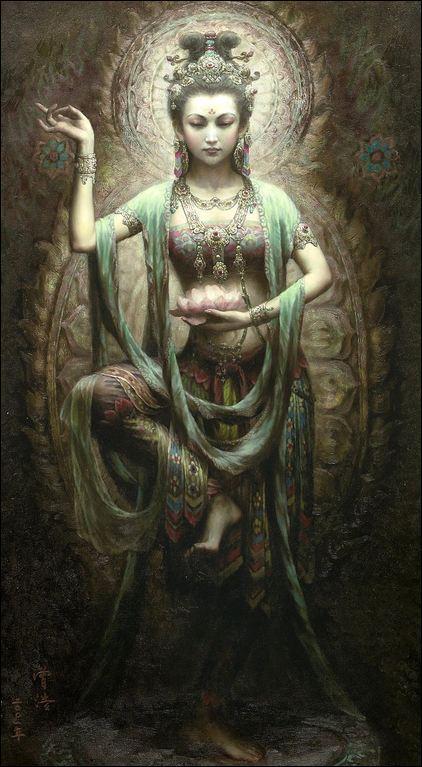

Teachings in Chinese Buddhism
Teachings in Chinese Buddhism is a collection of selected and translated articles from five books in the Third volume of the Chinese Miao Yun Collection; namely “The Dharma is the Saver of the World”, “The Three Essentials in Practicing the Teaching of the Buddha”, “The Buddha lives in the world”, “To investigate the Dharma according to the Teachings of the Buddha” and “My view on Religions”. These texts are from the Mahayana tradition as it is practiced traditionally in China. Download the free ebook here (257 pages):

Teachings in Chinese Buddhism
What is Chinese Buddhism?
Buddhism in China presents a journey of continuous evolution, cultural assimilation, and spiritual ideology that dates back to the first century CE. Chinese Buddhism, a constituent of East Asian Buddhism, has played a crucial role in shaping the country's philosophy, arts, politics, and sociology. Through numerous transformations and reinterpretations over the centuries, it has woven itself into the fabric of Chinese culture and has significantly contributed to the spiritual lives of millions.
Chinese Buddhism originated from the Indian subcontinent, the birthplace of Buddhism. Its introduction to China is largely attributed to the bustling interaction along the Silk Road, a network of trade routes that linked the East and West, facilitating not just the exchange of goods, but also culture, religion, and philosophy.
The earliest documented transmission of Buddhism to China is during the Han dynasty, with references to Buddhist monks and translated sutras appearing in Chinese historical records. These early transmissions laid the groundwork for a more profound proliferation of Buddhist ideology throughout the nation, which would take place in subsequent dynasties.
The Flowering of Schools and Philosophical Developments
The efflorescence of Buddhist thought in China led to the establishment of various schools, each interpreting the teachings of Buddha through different philosophical lenses. Among these, Chán (Zen in Japanese), Pure Land, Tiantai, and Huayan became highly influential.
1. Chán Buddhism: Known for its emphasis on meditative practice and enlightenment, Chán Buddhism uniquely adapted Buddhist principles with ancient Chinese thought, including Daoism and Confucianism. This school emphasizes direct insight gained through meditation and interaction between masters and students, famously illustrated through enigmatic dialogues known as "koans."
2. Pure Land Buddhism: Centered around the belief in the Western Paradise, or "Pure Land," of Amitābha Buddha, this devotional sect emphasizes faith and chanting practices as a path to rebirth in this realm of awakening. Its accessibility and simple practices contributed to its widespread popularity among both monastic and lay practitioners.
3. Tiantai: Based on the Lotus Sutra's teachings, the Tiantai school promoted the perspective of the inherent enlightenment of all beings and the concept of the "One Vehicle," which integrates all diverse Buddhist teachings into a single, coherent system.
4. Huayan: Drawing deeply from the Avataṃsaka Sūtra, this school is known for its profound and intricate philosophy, emphasizing the interpenetration of all phenomena and the notion that one contains all, in a vision of the universe as a perfect and harmonious totality.
Cultural Integration and Syncretism
Chinese Buddhism never existed in isolation. Instead, it engaged in a complex process of adaptation and transformation, blending seamlessly with the pre-existing Confucian and Daoist traditions. Temples often housed shrines dedicated to figures from different traditions, while Buddhist precepts influenced Chinese literature, art, and imperial policy.
In art, Buddhist influence manifested in various forms, from the majestic Giant Buddha statues carved into cliffs to the intricate paintings and sculptures depicting various Buddhas, bodhisattvas, and deities, illustrating the rich cosmology of Buddhist belief. Moreover, Buddhist festivals became part of the community's cultural life, integrating rituals, food, and customs that solidified the religion's role within the societal framework.
Challenges, Resurgence, and Contemporary Practice
Like many spiritual traditions, Buddhism in China has faced challenges, including periods of imperial suppression, most notably during the Tang dynasty, and severe restrictions and destruction during the Cultural Revolution of the 20th century. However, the post-Mao era has seen a revival, with monasteries being restored and a growing interest among Chinese people in Buddhist philosophy and meditation, reflecting the universal themes of suffering, liberation, and compassion.
In the contemporary era, Chinese Buddhism negotiates its place among rapid modernization and globalization. Monastics and lay practitioners are harnessing technology and modern communication to disseminate teachings, while engaging in social causes such as charity, environmental conservation, and cultural preservation, thereby reinterpreting the application of the Buddha's teachings in the context of contemporary societal issues.
Chinese Buddhism, with its intricate history, broad philosophical dimensions, and profound cultural impact, remains an integral component of China's spiritual heritage. As it continues to evolve and adapt to the rhythms of modern society, it offers enduring insights and practices aimed at understanding the human condition, fostering a harmonious existence with the world, and attaining spiritual liberation. Beyond merely a religion, Chinese Buddhism represents a perennial flow of wisdom and compassion through the heart of Chinese civilization.
Read the full article
1 note
·
View note
Photo
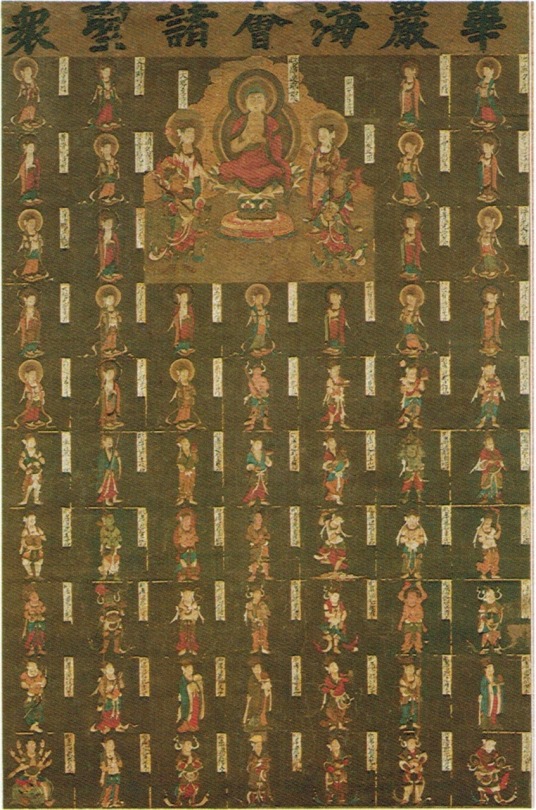
A hanging scroll of the Kegon Kaie Shoshōjū Mandara (華厳海会諸聖衆曼荼羅), Mandala of the Saints & Divinities of the Flower Ornament Ocean Assembly, currently stored in the Founder’s Hall (開山堂 Kaisandō) on the grounds of Kōzanji Temple (高山寺) up in northwest Kyoto
Prominent at the center top is the cosmic buddha Vairocana (毘盧遮那仏) attended by Kannon Bodhisattva (観音菩薩) & Seishi Bodhisattva (勢至菩薩) and guarded by Bishamonten (毘沙門天) & Jikokuten (持国天), with the 61 smaller figures representing various holy personages who appear in the Avataṃsaka Sūtra (華厳経 Kegonkyō)
Image from a booklet acquired at the temple March 30, 1997
#japanese art#buddhist art#曼荼羅#mandala#華厳宗#kegon#華厳経#kegonkyo#avatamsaka sutra#京都#kyoto#高山寺#kozanji#kosanji#開山堂#kaisando#華厳海会諸聖衆曼荼羅#kegon kaie shoshoju mandara#crazyfoxarchives
30 notes
·
View notes
Text
interfaith things that make me feel emotional, part 1/?
"Split the atom's heart, and lo! Within it thou wilt find a sun." - The Seven Valleys (Haft-Vádí)
"In each atom of the realms of the universe,
There exist vast oceans of world systems." - The Flower Garland Sutra (Avataṃsaka Sūtra)
2 notes
·
View notes
Photo

~ Where Science and Buddhism meet ~(video link in bio) Science and Buddhism are actually two sides of the same coin. Especially recent times more scientific findings have proved what Buddha has said 2600 years ago. For instance, Buddha said all phenomena are illusions and arise from Emptiness. The concept of emptiness (Shunyata) is an important one - the core teaching in Mahayana Buddhism. Emptiness is where all things arise from and return to. When we see the reality most of us just see materials and think they are solid and fixed. But what Buddha says is that reality is simply a projection from the mind and it's not fixed - it changes according to our perception (mind and consciousness) and also arise from Emptiness. Quantum physics can now prove what Buddha said was absolutely right. Materials are made up by particles (at first scientists think particles are fixed until they further discover more and more smaller particles and then realise particles are in fact largely empty space - wavelike), and the movement of the particles can change according to the human consciousness (mind). Scientists have also proved what Buddha said about oneness and interconnectivity - all things in the Universe are connected no matter how far away we are. Oneness within all things and all beings. Also the Mahayana Buddhist cosmology resonates well with modern scientic findings that there are actually infinite worlds and infinite universes (multiverse). Buddha has said this long ago, for instance in the Avataṃsaka Sūtra (华严经)(one of the most important Mahayana Sutras) which describes a cosmos of infinite realms upon realms, mutually containing one another (so one should not be surprised when Buddha told us there's a world called Western Pure Land of Ultimate Bliss and a Buddha called Amitabha Buddha who is right now teaching Dharma there - Infinite worlds and infinite Buddhas). It's great to see (and a comfort to know) Science is finally catching up with Buddhism. One may ask how did Buddha know about this? He doesn't have any telescope then. Even if he has telescope like now, one could not discover much with the telescope. (more in comment) https://www.instagram.com/p/CCe4S0Jlf49/?igshid=9clj1iub00mn
0 notes
Text
Huayan
Huayan o la escuela Huayan (en chino, 華嚴宗; pinyin, Huáyán Zōng, del en sánscrito: Avataṃsaka) o Guirnalda de Flores es una filosofía budista Mahayana que surgió y tuvo auge en China durante la dinastía Tang. Se basa en el Sutra de la Guirnalda de Flores sánscrito (S. Avataṃsaka Sūtra, C. Huayan Jing) y en la extensa interpretación china del mismo, el Huayan lun. La denominación Guirnalda de…
View On WordPress
0 notes
Text
Avataṃsaka Sūtra describes a cosmos of infinite realms upon realms, mutually containing one another.
The interdependency of all phenomena (dharmas).
0 notes
Photo
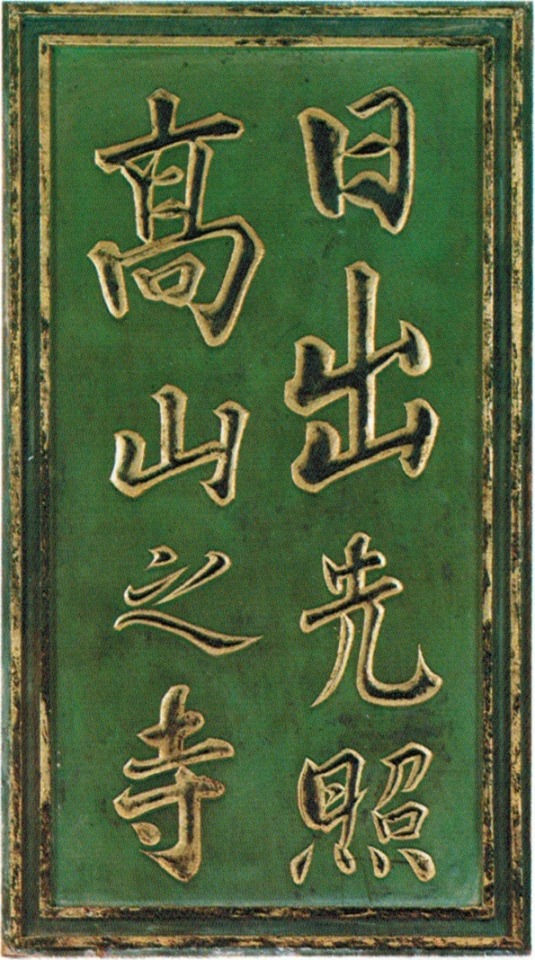
A plaque decorating the Sekisui’in Hall (石水院) on the grounds of Kōzanji Temple (高山寺) up in northwest Kyoto, gifted to the Kegon monk Myōe (明恵) by the Cloistered Emperor Go-Toba (後鳥羽上皇) in 1206
The text itself, “Temple where the sunrise illuminates the highest peaks” aptly describes this mountain temple as well as invoking a prominent metaphor from the Avataṃsaka Sūtra (華厳経 Kegonkyō) central to Myōe’s school of Buddhism
Image from a booklet acquired at the temple March 30, 1997
#japanese calligraphy#後鳥羽上皇#go-toba joko#京都#kyoto#高山寺#kozanji#kosanji#石水院#sekisuiin#明恵#myoe#華厳宗#kegon#crazyfoxarchives
11 notes
·
View notes
Text
The Avataṃsaka Sūtra 大方廣佛華嚴經(Sanskrit: महावैपुल्यबुद्धावतंसकसूत्र Mahāvaipulya Buddhāvataṃsaka Sūtra) is one of the most influential Mahayana sutras of East Asian Buddhism. The title is rendered in English as Flower Garland Sutra, Flower Adornment Sutra, or Flower Ornament Scripture.
The Avataṃsaka Sūtra describes a cosmos of infinite realms upon realms, mutually containing one another.
(It is traditionally believed that the Sutra was taught to the Bodhisattvas and other high spiritual beings while the Buddha was in samadhi.
Allegedly the Śākymauni Buddha became enlightened meditation Manjushri, Samantabhadra superior Bodhisattva explain the endless dharmadhatu preach, is considered to be the introduction of Buddhism is the most complete view of the world.
The spiritual journey, described in the sutra in minute detail with great beauty, which culminates in the realization of the highest awareness accessible to humanity, starts in the simple act of awakening of faith. This faith comes from the Buddha-nature inherent in the human heart, and provides the light that leads one beyond the familiar realm of meaningless obsessions, illusions, and worldly sentiments to one’s true abode—the boundless dharmadhatu.)
The sutra is also well known for its detailed description of the course of the bodhisattva’s practice through ten stages where the Ten Stages Sutra, or Daśabhūmika Sūtra (Ch. 十地經, Wyl. phags pa sa bcu pa’i mdo), is the name given to this chapter of the Avataṃsaka Sūtra. This sutra gives details on the ten stages (bhūmi) of development a bodhisattva must undergo to attain supreme enlightenment.
The sutra also touches on the subject of the development of the “aspiration for Enlightenment” (Bodhicitta) to attain supreme Buddhahood.
- 52 stages of bodhisattva practice to attain supreme Buddhahood.
The stages through which bodhisattvas advance from the time of their initial resolve until they finally attain Buddhahood.
The Ten Bodhisattva Bhūmi (Sanskrit; Tibetan “byang chub sems dpa’i sa”, enlightenment-being grounds/levels) are the ten stages on the Mahayana bodhisattva’s path of awakening.
The Sanskrit term bhūmi literally means “ground” or “foundation”. Each stage represents a level of attainment, and serves as a basis for the next one. Each level marks a definite advancement in one’s training, that is accompanied by progressively greater power and wisdom.
In Hua-yen Buddhism there are some 40 previous stages before the first bhumi:
10 faiths
10 abodes
10 practices
10 merit-transferences
52 stages -
10 faiths, 10 abodes, 10 practices,10 merit-transferences, 10 bhūmis,
Saṃyak-Saṃbodhi (等覺) as the 51st , and 52nd lastly the Wonderful Enlightenment ( 妙覺 ) , which is actually the position of Buddhahood .
( Bhumi (Buddhism), the ten stages a Bodhisattva advances through in the path to become a Buddha ).
0 notes
Text
The Avataṃsaka Sūtra 大方廣佛華嚴經(Sanskrit: महावैपुल्यबुद्धावतंसकसूत्र Mahāvaipulya Buddhāvataṃsaka Sūtra) is one of the most influential Mahayana sutras of East Asian Buddhism. The title is rendered in English as Flower Garland Sutra, Flower Adornment Sutra, or Flower Ornament Scripture.
The Avataṃsaka Sūtra describes a cosmos of infinite realms upon realms, mutually containing one another.
(It is traditionally believed that the Sutra was taught to the Bodhisattvas and other high spiritual beings while the Buddha was in samadhi.
Allegedly the Śākymauni Buddha became enlightened meditation Manjushri, Samantabhadra superior Bodhisattva explain the endless dharmadhatu preach, is considered to be the introduction of Buddhism is the most complete view of the world.
The spiritual journey, described in the sutra in minute detail with great beauty, which culminates in the realization of the highest awareness accessible to humanity, starts in the simple act of awakening of faith. This faith comes from the Buddha-nature inherent in the human heart, and provides the light that leads one beyond the familiar realm of meaningless obsessions, illusions, and worldly sentiments to one’s true abode—the boundless dharmadhatu.)
The sutra is also well known for its detailed description of the course of the bodhisattva's practice through ten stages where the Ten Stages Sutra, or Daśabhūmika Sūtra (Ch. 十地經, Wyl. phags pa sa bcu pa'i mdo), is the name given to this chapter of the Avataṃsaka Sūtra. This sutra gives details on the ten stages (bhūmi) of development a bodhisattva must undergo to attain supreme enlightenment.
The sutra also touches on the subject of the development of the "aspiration for Enlightenment" (Bodhicitta) to attain supreme Buddhahood.
- 52 stages of bodhisattva practice to attain supreme Buddhahood.
The stages through which bodhisattvas advance from the time of their initial resolve until they finally attain Buddhahood.
The Ten Bodhisattva Bhūmi (Sanskrit; Tibetan "byang chub sems dpa'i sa", enlightenment-being grounds/levels) are the ten stages on the Mahayana bodhisattva's path of awakening.
The Sanskrit term bhūmi literally means "ground" or "foundation". Each stage represents a level of attainment, and serves as a basis for the next one. Each level marks a definite advancement in one's training, that is accompanied by progressively greater power and wisdom.
In Hua-yen Buddhism there are some 40 previous stages before the first bhumi:
10 faiths
10 abodes
10 practices
10 merit-transferences
52 stages -
10 faiths, 10 abodes, 10 practices,10 merit-transferences, 10 bhūmis,
Saṃyak-Saṃbodhi (等覺) as the 51st , and 52nd lastly the Wonderful Enlightenment ( 妙覺 ) , which is actually the position of Buddhahood .
( Bhumi (Buddhism), the ten stages a Bodhisattva advances through in the path to become a Buddha ).
1 note
·
View note
Quote
(original (true) nature) Heart, Buddha, beings, three undifferentiated
- Avataṃsaka Sūtra ,(Flower Garland Sutra, Flower Adornment Sutra, or Flower Ornament Scripture.)
Wuji ( Without Ultimate )(Tao) produces Taiji (one), Taiji (two )produces Liangyi (Yin Yang), Liangyi produces Sìxiàng
-Zhouyi 周易, I Ching "Yì Jīng" , Classic of Changes, Book of Changes.
Tao produces one,One produces two,Two produce three,Three produce myriad things.
- Laozi 老子,Tao Te Ching (Dao De Jing)
( God ) Father, Son (Jesus Christ) , Holy Spirit
that the God of our Lord Jesus Christ, the Father of glory,
- Ephesians 1:17
( ...Whoever has seen me has seen the Father. How can you say, ‘Show us the Father’? Do you not believe that I am in the Father and the Father is in me?..the Father who dwells in me does his works. John 14:10 )
( In that day you will know that I am in my Father, and you in me, and I in you.John 14:20 )
( And the Lord is the Spirit.. .2 Corinthians 3:17 )
#Avataṃsaka Sūtra#God#I Ching#Tao#Tao Te Ching#True Nature#Wuji#Yi#Zhouyi#上帝#佛#华严经#周易#无极#易#易经#本性#道#道德经
0 notes
